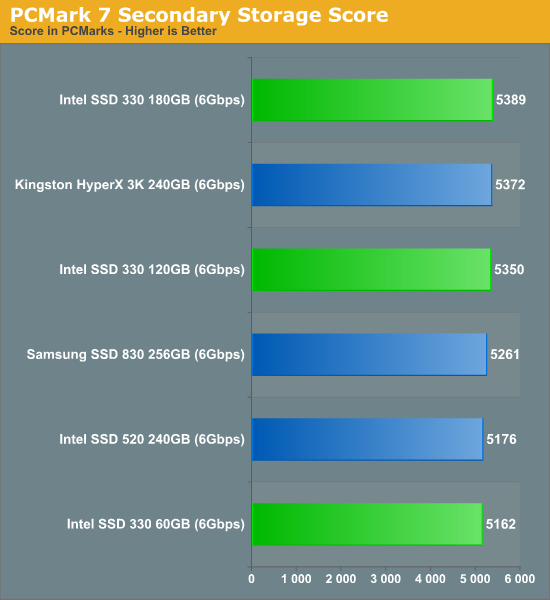The Intel SSD 330 Review (60GB, 120GB, 180GB)
by Anand Lal Shimpi on August 1, 2012 12:01 AM ESTPCMark 7
PCMark 7's secondary storage benchmark does little to show us differences between modern, high-performance SSDs as everything here scores within 5% of one another - but that's the point. For most mainstream client uses you'd be hard pressed to tell the difference between two good 6Gbps SSDs. Worry more about cost and reliability than outright performance if you're considering an SSD for a normal machine. Anything you see here will be much faster than a mechanical drive.

Performance Over Time & TRIM
SandForce's controllers have always behaved poorly if you pushed them into their worst case scenario. Should you fill a SF-2281 based drive completely with incompressible data then continue to write to the drive with more incompressible data (overwriting some of what you've already written) to fill up the spare area you'll back the controller into a corner that it can't get out of, even with TRIM. It's not a terribly realistic situation since anyone using an SF-2281 SSD as a boot drive will at least have Windows (or some other easily compressible OS) installed, and it's fairly likely that you'll have other things stored on your SSD in addition to large movies/photos. Regardless, it's a corner case that we do have to pay attention to.
As we found out in our 520 review, Intel's firmware isn't immune to this corner case. I filled a 120GB SSD 330 with incompressible data. I then ran a 60 minute 4KB random write torture test (QD32), once again, with incompressible data. Normally I'd use HDTach to chart performance over time however HDTach measures performance with highly compressible data so we wouldn't get a good representation of performance here. Instead I ran AS-SSD to get a good idea for incompressible sequential performance in this worst case state. Afterwards, I TRIMed the drives and ran AS-SSD again to see if TRIM could recover the drive's performance.
| Intel SSD 330 - Resiliency - AS SSD Sequential Write Speed - 6Gbps | |||||
| Clean | After Torture | After TRIM | |||
| Intel SSD 330 120GB | 148.9 MB/s | 96.3 MB/s | 94.4 MB/s | ||
This is really the biggest problem with SandForce drives. If you're primarily storing large amounts of incompressible data, sequential write speeds suffer even further over the long haul.










64 Comments
View All Comments
Ender17 - Wednesday, August 1, 2012 - link
Thanks Anand, you guys are awesome.Slash3 - Wednesday, August 1, 2012 - link
Ditto this sentiment. I've been coming to AT since it was a Geocities site and you never cease to impress me, Anand, with your willingness to address little things like this that pop up every once in a while.Thank you!
pandemonium - Wednesday, August 1, 2012 - link
*cheer*chaudx - Thursday, August 2, 2012 - link
Thanks for fixing that garbage!etamin - Wednesday, August 1, 2012 - link
It's nice to see SSD prices are hovering around the $1/GB mark these days. The 256GB Vertex 4 is looking awfully attractive (wonder how the reliability is?).I really liked the endurance testing on the 330's NAND, it really puts real world usage into perspective. On the other hand, I wonder if the rate of E9 falling is exponential rather than linear...
TrackSmart - Wednesday, August 1, 2012 - link
I wouldn't touch another OCZ branded SSD with a 10 foot pole. You often save $20 or get slightly higher performance (that is only visible in benchmarks), but the failure rate on their products is just unacceptably high. And yes, I'm basing this on the data that is available (which is imperfect), the huge proportion of negative reviews for failed drives (also imperfect info), and my own personal experience (limited sample size). I say go Intel, Crucial, or Samsung - unless you really enjoy the RMA process. Plus, the good deals almost always involve rebates. I hate rebates.Some data (even if imperfect):
http://www.behardware.com/articles/862-7/component...
Zoomer - Wednesday, August 1, 2012 - link
It's more like 66¢ per gb on sale.lyeoh - Wednesday, August 1, 2012 - link
Go to newegg/amazon, go look at the various SSDs. Go compare the percentage of one stars OCZ gets vs say Intel or Crucial or Samsung get. All manufacturers have duds (and stupid customers), but if you read the reviews and look at the stats, you'd see not all manufacturers are equally crap when it comes to SSDs.See also the OCZ return rates from the various behardware reports (they have a long track record of high return rates). It's so bad that I'd avoid sandforce based stuff including Intel's versions.
Perhaps they are more sensitive to crappy power supplies or users... Maybe things have improved.
Flying Goat - Wednesday, August 1, 2012 - link
Nice? It's bloody awful! I bought a pair of 128s earlier this year for almost twice that. :( Well...1.5 times that.mayankleoboy1 - Wednesday, August 1, 2012 - link
Could the E9 readings be faulty due to a older software? Did you check with other SMART readers?